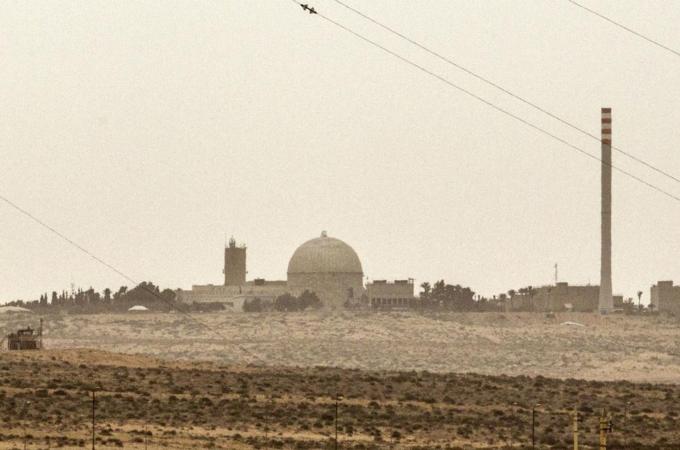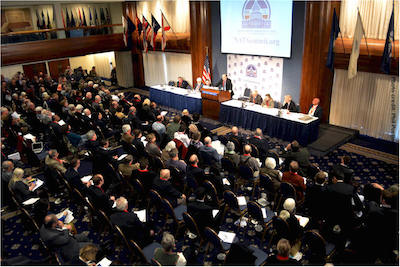How Washington helped create Israel’s secret nuclear arsenal
Sep 3 2014 / 3:14 pm
By Philip Giraldi.
Al Jazeera – Recently declassified documents reveal that consideration of how and when the White House can or should pressure Israel over policies damaging to the United States has been a contentious issue for quite some time. The 107 pages of formerly top secret memos, dating from 1968-9, relate to deliberations over what to do about the Israeli nuclear weapons programme. Prior to that time, the US position had been clear, supporting the principle that nuclear weapons should not be introduced into the Middle East.
The declassified story
President John F Kennedy was convinced that Israel was building a weapon and fully intended to force its government to abandon the effort and join the Nuclear Non-Proliferation Treaty (NPT), which Washington supported. Kennedy’s death and his replacement by the strongly pro-Zionist Lyndon B Johnson did not shift the general perception that a nuclear armed Israel would not be in US interest, though Johnson notably refused to tie the impending sale of 50 F-4 Phantom fighter-bombers to Israeli abandonment of both its nuclear and ballistic missile programmes, as the Pentagon had recommended.
President Richard M Nixon arrived on the scene in January 1969, a year and a half after Israel’s successful attack on Jordan, Syria, and Egypt. Israel was still fighting Egyptians in Sinai in the so-called War of Attrition, a conflict which Washington was attempting to mediate to reopen the Suez Canal to shipping. Nixon, regarded by some as anti-Semitic, was no natural friend of Israel but his foreign policy was strictly pragmatic as he sought to disengage from Vietnam and counter communist advances in other parts of the globe. In the Middle East, he saw Israel as a potential asset given the de facto alignment of states like Syria and Egypt with the Soviet Union.
Israel’s nuclear programme relied on assistance from Jews in the United States. The Federal Bureau of Investigation tracked the diversion of enriched uranium from the Nuclear Materials and Equipment Corporation (NUMEC) plant in Pennsylvania in the mid-1960s. Though it could not demonstrate that Israel had been the recipient of the largesse, it reported a number of contacts between the owner Zalman Shapiro and Israeli intelligence officer Rafael Eitan. Eitan was the Mossad case officer who also handled Jewish American spy Jonathan Pollard, who was involved inreportedly the most damaging espionage case in US history.
The CIA also was aware of the loss of the nuclear material and believed it had been stolen and shipped to the Israeli nuclear research centre at Dimona, to which the US had only limited access. Based on intelligence, by late 1968 both the CIA and the Pentagon’s Defense Intelligence Agency concluded that Israel already had succeeded in developing nuclear weapons.
The declassified documents demonstrate that an alarmed US government initially sought three assurances from Israel: that it would stop short of constructing an actual nuclear weapon in exchange for Washington’s acceptance of the deployment of Israeli developed “deterrent” Jericho ballistic missiles, that it would join the NPT and that the Dimona facility be opened to regular US inspection. If Israel refused, US sanctions might include restricting the sale of conventional weapons and delaying the transfer of the Phantom jets.
|
|
| Rebel Architecture – The architecture of violence |
From the start, Israel obfuscated the issue by playing with definitions, insisting that “introducing” a nuclear weapon to the Middle East would only occur when a device was assembled, tested and its existence publicly acknowledged. The US insisted that a weapon would be “introduced” as soon as it would be put together and be capable of exploding.
The hardliners in the administration – including Secretary of Defense Melvin Laird – contended that a nuclear Israel would at a minimum provoke an arms race in the Middle East. It would also perpetuate low intensity warfare between Israel and the Arabs due to the latter’s perceived military inferiority, would tie Arab states more closely to Moscow bringing the Cold War to the region increasing the risk of a great power nuclear confrontation, and would inevitably result in Washington being blamed for the development, damaging a broad range of regional interests. The credibility of the NPT would also be damaged, possibly leading to mass defections from it.
Those who wanted to halt the programme argued for sanctions on Israel if it failed to accede to all three US demands. They observed the implausibility of the Israeli argument that it needed the weapons as a deterrent as it clearly intended to keep the programme secret, meaning that no adversary would necessarily be put off by something that might not exist. Also, US planners feared the Samson option, a plan to destroy the entire Middle East if Israel were about to be overrun.
The debate over what to do about Israel ultimately pitted a proposed aggressive response backed by sanctions versus “persuasion”. A proposal to mollify Israeli security concerns by offering a defence guarantee was even considered but rejected because it would mean an “open ended commitment without any control over Israeli actions.”
The discussion, taking place in the months before a state visit by Israeli Prime Minister Golda Meir, gradually moved in the direction of accommodation guided by the State Department’s Joseph Sisco, accepting that the Israeli programme was a reality and that any pressure would only accelerate the timetable and broaden the scale while damaging other interests. As the documents describe it, the White House eventually backed off completely, agreeing to accept assurances of Israel’s “technical option” to build nuclear weapons, meaning that it had all the pieces in place but had not yet done so. In other words, the US pledged itself to keep the Israeli secret and to regard the programme itself as acceptably ambiguous.
It was a secret that both Washington and Tel Aviv connived at in spite of mounting evidence that Israel had a substantial supply of nuclear weapons, which included reports of a possible Indian Ocean test detonationconducted in cooperation with the South African apartheid government in 1979. Though Israel has never actually confirmed that is has a nuclear arsenal, President Jimmy Carter reportedly came close to exposing the NUMEC theft in 1977 but demurred because he was attempting to make peace between Israel and Egypt and feared that the release of the story would damage the negotiations.
Ignoring Israeli interests
So the tale of 1969 is how the US backed off of its intention to block Israeli nuclear proliferation and instead became complicit in the crafting of the current fiction regarding Israel’s weapons of mass destruction. But more interesting is the tone of the declassified documents: drafted and debated in light of actual US interests in the Middle East. Israeli concerns are addressed in passing but they do not drive the process and domestic political pressures from a still growing Israel lobby, are only mentioned once: “They could use their full range of assets in the United States to persuade us to abandon our demands.”
Israeli Ambassador Yitzhak Rabin is described at one point as “stonewalling”. A memo notes that Congress would never go along with giving security guarantees to Israel while another from the Deputy Secretary of Defense concludes laconically that “not to lean on them would involve us in a conspiracy with Israel which would leave matters dangerous to our security in their hands.”
Another official wrote “Whatever the validity of Israel’s position from its own standpoint, it does not coincide with the interests of the United States and, in fact, constitutes the single most dangerous phenomenon in a region already dangerous enough without nuclear weapons.” A senior Pentagon official adds: “Our demands must be unequivocal. Moral suasion and prolonged discussion does not work with Israel.”
It is difficult to imagine similar opinions being voiced today in the corridors of power in Washington, or at least not openly. Israel is America’s greatest friend and most important ally, or so we are told. Clearly many things have changed since 1969.


